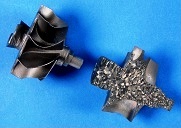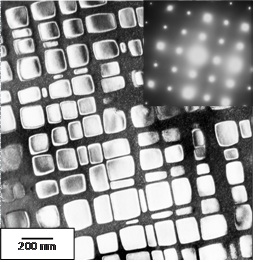Areas of focus
The chair of Microstructural Material Design focuses on the following topics:
- Titanium aluminides (TiAl)
- Novel Cobalt-based superalloys
Titanium aluminide alloys (TiAl)
Titanium aluminde alloys (TiAl) are promising materials as replacement for heavier Nickel-based alloys in high temperature aircraft and automotive engine applications. Due to their nanoscale microstructure they have excellent strength. However, the ductility is limited. In addition, these alloys are very sensive to manufacturing conditions, since even minor deviations lead to unacceptable properties.
Both the development of alloys combining better properties with easier manufacturability and the development of novel manufacturing processes that are particularly suitable for TiAl alloys are the important research areas. Recently, TiAl alloys have been used in aircraft turbines as a material for the turbine blades. This blades are manufactured either by conventional casting or forging processes. At the same time, there is a great interest in alternative manufacturing processes. These are attractive for component manufacturing as well as repair and maintenance. However, on the alloy development site, almost exclusively the processing of cast or forged alloys with these processes is state of the art. Even in this case, the adaption of the alloys to forging processes is still incomplete, since the necessary forming temperatures between 1100 and 1250 °C bring currently available die materials to ther limits. Currently a targeted adaptation of the alloy composition to other processes does not happen or only sporadically on a laboratory scale. Novel processes of interest here are additive manufacturing (AM) by selective laser or electron beam melting, soldering, welding and build-up welding or metal injection molding. Many of these processes are based on powder metallurgy methods. Poweder metallurgy produced materials are chemically very homogeneous, but the high sensitivity of titanium and TiAl against certain impurities makes high demands on the process technology.
Novel Cobalt-Based Superalloys
Despite the fact that some properties of Cobalt-based superalloys are superior, as for example better corrosion resistance or higher melting point, Nickel-based superalloys increasingly replaced Cobalt-based superalloys for high temperature applications. This is due to clearly superior mechanical properties of Nickel-based superalloys compared to conventional Cobalt-based superalloys. The reason for this is the so-called γ'-precipitate phase in Nickel-based superalloys. This phase is responsible for the extraordinary high temperature strength of Nickel-based superalloys. Recently, a similar precipitate phase was found in the Co-Al-W system. This has the potential to combine the advantages of Nickel- and Cobalt-based superalloys.


